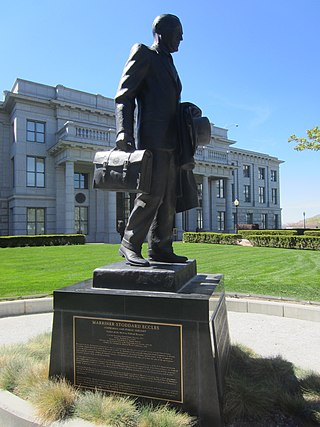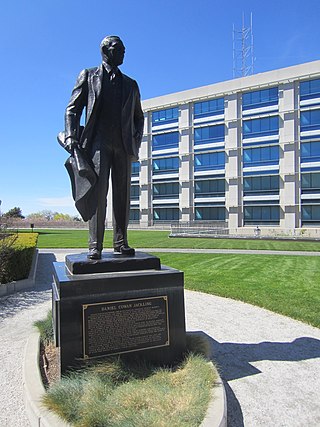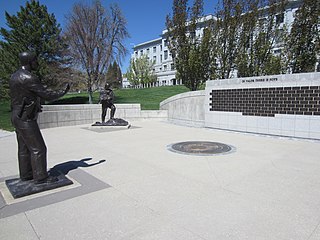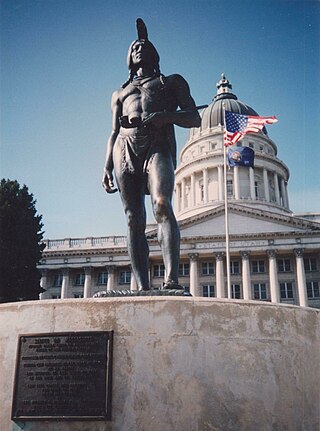
Philo Taylor Farnsworth was an American inventor and television pioneer. He made the critical contributions to electronic television that made possible all the video in the world today. He is best known for his 1927 invention of the first fully functional all-electronic image pickup device, the image dissector, as well as the first fully functional and complete all-electronic television system. Farnsworth developed a television system complete with receiver and camera—which he produced commercially through the Farnsworth Television and Radio Corporation from 1938 to 1951, in Fort Wayne, Indiana.

The National Statuary Hall is a chamber in the United States Capitol devoted to sculptures of prominent Americans. The hall, also known as the Old Hall of the House, is a large, two-story, semicircular room with a second story gallery along the curved perimeter. It is located immediately south of the Rotunda. The meeting place of the U.S. House of Representatives for nearly 50 years (1807–1857), after a few years of disuse it was repurposed as a statuary hall in 1864; this is when the National Statuary Hall Collection was established. By 1933, the collection had outgrown this single room, and a number of statues are placed elsewhere within the Capitol.

The National Statuary Hall Collection in the United States Capitol is composed of statues donated by individual states to honor persons notable in their history. Limited to two statues per state, the collection was originally set up in the old Hall of the House of Representatives, which was then renamed National Statuary Hall. The expanding collection has since been spread throughout the Capitol and its visitor center.

Martha Maria "Mattie" Hughes Cannon was a Welsh-American politician, physician, Utah women's rights advocate, suffragist, and a polygamous wife. Her family immigrated to the United States as converts to the Church of Jesus Christ of Latter-day Saints and traveled West to settle in the Utah territory with other church members. She started working at the age of fourteen, and at sixteen she enrolled in the University of Deseret, receiving a bachelor's degree in Chemistry. She later attended the University of Michigan and received an M.D..

The Cannon family is a prominent U.S. political family in the states of Utah, Nevada and Idaho which descends from the 19th century marriage of George Cannon and Ann Quayle before their emigration from Peel, Isle of Man. The family's most powerful politician was their oldest son George Q. Cannon. The family is connected by marriage to the Bennion, Taylor, Wells and Young political families.

The Utah State Capitol is the house of government for the U.S. state of Utah. The building houses the chambers and offices of the Utah State Legislature, the offices of the Governor, Lieutenant Governor, Attorney General, the State Auditor and their staffs. The capitol is the main building of the Utah State Capitol Complex, which is located on Capitol Hill, overlooking downtown Salt Lake City.

Emmeline Blanche Woodward Harris Whitney Wells was an American journalist, editor, poet, women's rights advocate, and diarist. She served as the fifth Relief Society General President of the Church of Jesus Christ of Latter-day Saints from 1910 until her death. She represented the state of Utah at both the National and American Women's Suffrage conventions and was president of the Utah Woman's Suffrage Association. She was the editor of the Woman's Exponent for 37 years. She was a plural wife to Newel K. Whitney, then Daniel H. Wells.

Angus Munn Cannon was an early Latter Day Saint leader and Mormon pioneer.
Pingree is an unincorporated community in Bingham County, Idaho, United States. Pingree is located on Idaho State Highway 39 southwest of Blackfoot and northwest of Pocatello.

James Patten Paul was a Mormon pioneer from Ayrshire in Scotland who trekked to Utah with the David H. Cannon Company in 1861. His chief claim to fame is that he was the stepfather and mentor of doctor, suffragist and first female state senator of the USA Martha Hughes Cannon ("Mattie"). He was also the father of Professor Joshua Hughes Paul, a Mormon university president and newspaper editor, Utah detective Adam Milroy Paul, and silent actor Logan Paul, who, during his career in New York, portrayed, among others, Abraham Lincoln.
Senator Cannon may refer to:
Ben Hammond is an American sculptor and painter. His sculpture of Martha Hughes Cannon will represent Utah in the National Statuary Hall Collection in the United States Capitol. The 7 foot, 6 inch statue of Cannon will be molded from bronze and will replace a statue of Philo T. Farnsworth.

A 2008 bronze statue of Marriner Stoddard Eccles by James Mark DeGraffenried is installed outside the Utah State Capitol in Salt Lake City, Utah.

A statue of Thomas L. Kane by Ortho R. Fairbanks is installed outside the Utah State Capitol in Salt Lake City, in the U.S. state of Utah.

A bronze statue of Daniel C. Jackling by Avard Fairbanks is installed outside the Utah State Capitol in Salt Lake City, in the U.S. state of Utah.

The Utah Law Enforcement Memorial by Lena Toritch is installed outside the Utah State Capitol in Salt Lake City, in the U.S. state of Utah.

A statue of Massasoit by Cyrus E. Dallin is installed outside the Utah State Capitol in Salt Lake City, Utah, United States.
A bronze statue of Martha Hughes Cannon by Ben Hammond is installed in the United States Capitol Visitor Center, in Washington, D.C., United States.

Two pairs of lion sculpture are installed at the Utah State Capitol in Salt Lake City. The original statues were created by Gavin Jack with cement in 1915, and repaired by Ralphael Plescia in 1977. Replacements were sculpture by Nick Fairplay with Italian marble. The sculpture are known as Fortitude, Honor, Integrity, and Patience.

Ever Pressing Forward is a bronze sculpture installed on the exterior east side of the Pioneer Memorial Museum in Salt Lake City, Utah. It was sculpted by Karl Alfred Quilter (1929-2013) in 2001. Across the street is the associated Lest We Forget monument and plaque are on the southwest grounds of the Utah State Capitol Building.

















